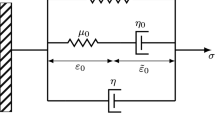Abstract
The motion of a planet consisting of a mantle and a core (solid bodies) connected by a viscoelastic layer and interacting with each other and an external point mass by the law of gravitation is considered. The mutual motions of the core and mantle are investigated assuming that the centers of mass of the planet and external point mass moves along undisturbed Keplerian orbits around the common center of mass of the system. The planetary core and mantle have an axial symmetry and different principal moments of inertia, which leads to a displacement of the center of mantle relative to the center of core and to their mutual rotations. The results obtained on the basis of averaged equations are illustrated by the example of the Earth–Moon system.
Similar content being viewed by others
REFERENCES
Darvin, J.G., Prilivy i rodstvennye im yavleniya v Solnechnoi sisteme(Tides and Related Phenomena in the Solar System), Moscow: Nauka, 1965.
Love, A.E.H., A Treatise on the Mathematical Theory of Elasticity, 4th ed., Cambridge: Cambridge University Press, 1927. Translated under the title Matematicheskaya teoriya uprugosti, Moscow: Otd. Nauchn. Tekh. Inform., 1935.
Zharkov, V.N., Vnutrennee stroenie Zemli i planet(Interior Structure of the Earth and Planets), Moscow: Nauka, 1983.
Vil'ke, V.G., Analiticheskaya mekhanika sistem s beskonechnym chislom stepenei svobody(Analytical Mechanics of Systems with Infinite Number of Degrees of Freedom), Moscow: Izd. Mekhan.-Matem. Fak. Mosk. Gos. Univ., 1997, Parts 1, 2.
Sidorenko, N.S., Fizika nestabil'nostei vrashcheniya Zemli (Physics of Instabilities in the Earth's Rotation), Moscow: Fizmatlit, 2002.
Barkin, Yu.V., Ob”yasnenie endogennoi aktivnosti planet i sputnikov i ee tsiklichnosti, Izvestiya RAEN, sektsiya nauk o Zemli. Dekabr' 2002. Vyp. 9. S. 45-97.
Vil'ke, V.G., Teoreticheskaya mekhanika(Theoretical Mechanics), Moscow: Mosk. Gos. Univ., 1997.
Beletskii, V.V., Dvizhenie sputnika otnositel'no tsentra mass v gravitatsionnom pole(Satellite Motion in Gravitational Field Relative to Its Center of Mass), Moscow: Mosk. Gos. Univ., 1975.
Rights and permissions
About this article
Cite this article
Vil'ke, V.G. Motion of a Planet with a Complex Structure. Cosmic Research 42, 374–381 (2004). https://doi.org/10.1023/B:COSM.0000039737.94955.08
Issue Date:
DOI: https://doi.org/10.1023/B:COSM.0000039737.94955.08



